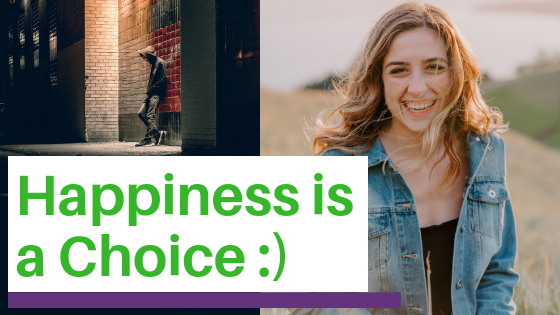Do you think that ‘happiness’ and ‘work’ are two words that don’t belong in the same sentence? Well, it might surprise you to learn that you can choose happiness as a way of life, to great effect.
But this seems awfully simplistic, doesn’t it? Aren’t some people simply unable to be happy? And what is happiness, anyway?
Dr Jennifer Guttman believes that we have lost the real sense of what the word happiness means. She believes, after 20 years of practice as a psychologist, that ‘happiness’ is really ‘satisfaction’. In Dr Guttman’s view, satisfaction is a feeling of ease or contentment.
Is she right?
The positive psychology definition suggests that happy people experience ‘frequent positive emotions’ like ‘joy, interest, and pride’.
And the philosophical view is that ‘it is not how much we have, but how much we enjoy, that makes happiness’.
These definitions suggest that Dr Guttman is probably right. When it comes down do it, we can choose to enjoy the things in our lives. That choosing is what is going to create the conditions for satisfaction and, eventually, a sense of happiness. In any case, you’ll have more positive emotions as a result.
It’s true that we can choose to be happy. When we’re happy, we become more productive, resilient people. As the best versions of ourselves, we become true assets to the organizations we work for.
If it’s feeling, right now, that getting from here to happy is a struggle, you have to know how to do it. And the first step is recognising that happiness takes work.
Recognize that happiness takes work
When you choose the path to happiness, you are choosing to think, feel, and do things differently. You may have established patterns and habits that need to change. And if you’ve ever tried to exercise for 30 minutes every day for a month, you know how hard it is to change a habit.
Choosing to think differently, feel differently, and do things differently feels like work, because it is. You’re trying to shift an entire way of existing, in multiple planes, all at once.
But it isn’t impossible. You just need the right motivation, and the right tools.
Certified Life Coach Michael Feeley knows better than most that in order to be happy, you need to make a conscious decision to pursue happiness and put in the time and effort needed to attain it. As Feeley so candidly points out, he grew up in a decidedly unhappy home, one where an alcoholic father reigned over the household and an unhappy marriage left a cloud over the family. Feeley hated being at home—the source of his unhappiness. And so, he make the decision to proactively pursue the things that did make him feel happy, rather than wallowing in those that made him miserable.
‘Studying acting and singing brought me tremendous joy and freedom,’ he says. ‘I was out rehearsing, working and learning with positive people; expressing myself and giving form to my feelings. My life had meaning and purpose and real rapture.’
With The ORANGES Toolkit, we learn how we see things through three lenses: Personal (me, or not-me), permanent (always, or not-always) and pervasive (everything, or not-everything). Changing them starts with how you explain them to yourself.
For example, if a bad event happens, an optimist will explain it to themselves as being temporary, and that it only affects a limited situation. But a pessimist will explain the same event to themselves as being persistent, and related to all other negative things in his life. Shifting how you think, first, is a precursor to creating the change that inspires how happy, optimistic, or satisfied you feel.
The effort of happiness isn’t a one-time-only effort. It’s a continual process of orienting yourself onto an optimistic path. If you’re one of those who just seem naturally to be that way, you are still doing this orientation, but you don’t realise it.
How does this relate to the workplace?
Good question. Many people see work as a place to simply do the things which they are paid to do (and, conversely, the things they would not be doing unless they were paid). Apparently, happiness has little, if anything, to do with it.
But what would you say to the knowledge that your working life is getting longer, not shorter? According to this study conducted across the European Union, the average length of an individual’s working life in the year 2017 was 35.9 years, up a full three years from on data captured in the year 2000.
If you could choose to be happy, wouldn’t those years fly by, more smoothly, more enjoyable, and more productive? Of course they would.
With this in mind, here are some key points about happiness, and what you can do to maintain yourself in a happy frame of mind.
Step 1: Improve your performance
It turns out that when you do better, you feel better. A simple way of thinking about happiness, or satisfaction, is simply to work at improving your own performance.
Cynthia D. Fisher, of Bond Business School, points out in her paper Happiness At Work that people feel more satisfied than usual when they believe that they are performing better than usual.
If you don’t have a baseline, talk to your manager about creating one to measure yourself against. Or, if you work on a computer all day, use a tool like RescueTime that will track what applications you use, and allow you to see the pattern of your day. Automatically capturing data is a first, important step.
Step 2: Remember that happiness comes before success
Yes, it’s true. To be successful, you have to get happy first. Life Coach and ‘Happyologist’ Susanna Newsonen says that our usual way of thinking – that happiness follows success – is backwards.
In this piece from Psychology Today, by becoming happy, we ‘…activate more of the learning centres in [the] brain and as a result can use more of [the] brain’s capacity.’
When we can use more of our brain’s capacity, we are able to achieve more significant things, more often. By focusing on happiness, your success won’t be far behind.
Step 3: Know what to do to maintain your positive state
Remember that ‘effort’ that we talked about earlier? Maintaining your positive state is something that you choose to do every single day. It’s a matter of waking up and choosing to have a good day.
One way that you can do this is to refuse to get out of bed until you feel good about your day. To do this, run through your day in your mind and see it running smoothly, and how good you feel at the end of it. Then when you’re smiling, get out of bed and continue your day. This is a top tip of author Miriam Castilla.
This choice to seize happiness is something that certified psychosocial rehabilitation practitioner Daniel Matthews likens to a runner taking in a breath of air.
‘Each inhalation is essential,’ he says, ‘and with every inhalation, exhalation must follow.’
That is to say, happiness is something that has to be constantly maintained so that it can become a subconscious state of being, instead of something that you chase. In a case study, Matthews points to the island nation of Fiji, where many lack basic amenities such as running water. And yet, he says, they feel they lack for nothing, because they live off the land, and enjoy the broad support of their community. Even though these people lack what many in the West would believe to be a basic necessity for life – let alone happiness! – they are still able to find a way to choose happiness as a way of life.
Why should you make happiness a priority?
In The Business Case for Happiness, a case study prepared for the Stanford Graduate School of Business, the reason is because it improves your ability to be creative, to earn money, and to build great relationships. As an employer, putting happiness first will actually drive profits.
Here is an excerpt about why happiness is so important:
We care because investing in happiness-both for employees and customers-drives profits for firms. For example, employees are more likely to come up with a creative idea when they’re in a better mood than normal, and customers will pay more for a great experience. When they are unhappy, not surprisingly, employees are more likely to turnover or call in sick. Unhappy consumers share their negative experiences more than they share their positive ones. People are more likely to seek variety in their choices when they are unhappy, thus eroding brand loyalty.
Your happiness, and the happiness of your team, will affect your business at every level, from creativity and innovation to customer care.
Remarkable, isn’t it, that a choice you make can do all of this?
You can find happiness with The ORANGES Toolkit
The ORANGES Toolkit is a program based on academic research and the study of workplace dynamics which provides both employers and employees with the tools they need to build, maintain, and grow the qualities of resilience, happiness, and overall mental well-being.




Leave A Comment